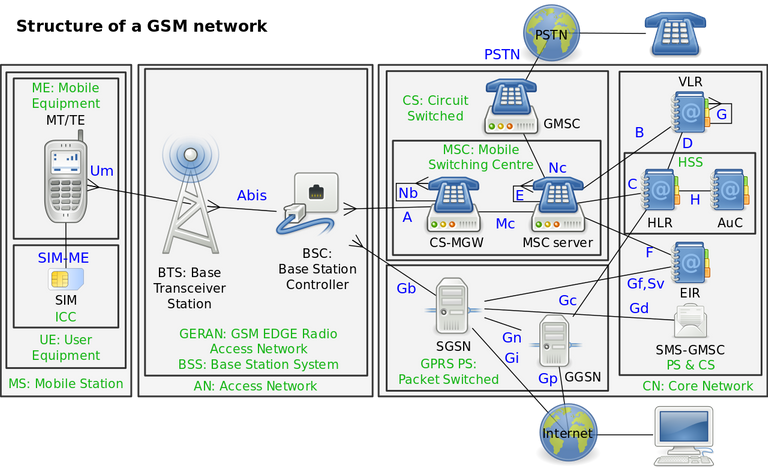Cell phones have been in existence for a long time now and it is true that humans have a cyclical codependence on them. Life is all about communication and there is no life without it. We all use cell phones; to make that office call, call our loved ones both home and abroad, to place a pizza order e.t.c. But the question is, how does it work? This is a question many of us including me have at a time asked.
Those not familiar with the tech-world are still puzzled with how this thing actually works till today. It’s a thing of wonder that you need not send letters no more like they did in the ancient and medieval times, when you need to wait for weeks or months to get a reply. That you can just pick a device and start communicating with another individual almost immediately, regardless of where he or she is.
Introduction to GSM Technology and a Brief History of GSMs
GSM - Global System for Mobile Communications is the most popular wireless cellular communication technique used by cell phones in the world today. It is a standard developed by the European Telecommunications Standards Institute (ETSI) to describe the protocols for second generation (2g) digital cellular networks used by mobile devices such as phones and tablets, first deployed in Finland in December 1991 (although the standard GSM was first developed in 1982).
Cellular networks are radio networks that consist of cells. Each cell is a cell site that consists of an elevated tower (the ones you see around) that contains transceivers (transmitters and receivers), signal processors, a timing receiver and electrical power sources. The size of each cell refers to the coverage area it is designed for.
The GSM Association claims about 80 percent of all mobile phones are using the GSM standard. GSM is a cellular network, the network these cell phones use. Each of these phones search for a cell in the area they are being used. There are five different cell sizes in a GSM network; macro, micro, pico, femto, and umbrella cells. The coverage area of each cell varies according to the implementation environment.
The GSM Network Structure
The GSM Network Structure can be divided into following sections:
Mobile Station: The mobile station is generally the mobile phone which consists of a transceiver, display and a processor. Each of these mobile stations (cell phones) consists of a unique identity stored in a chip known as SIM (Subscriber Identity Module). It is a small microchip which is inserted in the mobile phone and contains the subscription profile and address book.
Base Station Subsystem: The primary function of the Base Station Subsystem (BSS) is to connect the mobile station with the network subsystem via the air interface. It consists of the Base Transceiver Station (BTS) which contains the radio transceivers and handles the protocols for communication with mobiles. One or more Base Transceiver Station provides physical connection of a mobile station to the network in form of air interface. It also consists of the Base Station Controller (BSC) which controls the operation of the Base Transceiver Stations, basically the handover or power control. A BSC connects to the BTS over an Abis-interface. It consists of a database comprising the whole maintenance status of the BTS, quality of radio and terrestrial resources and BTS operations software.
Network and Switching Subsystem: Its basic function is to provide network connection to the Mobile Station. It provides the complete set of control and database functions needed to set up a call using encryption, authentication and roaming features. The main element of the Network Subsystem is the Mobile Switching Center (MSC) which provides access to networks like Public Switched Telephone Network (PSTN) exchange or Integrated Services Digital Network (ISDN) exchange.
It supports additional functionality like registration, authentication, call location and call routing to the subscriber and provides interfaces to Public Switched Telephone Network (PSTN) for connection with landline or interface to another Mobile Switching Centre (MSC) for connection to another mobile phone.
The Network Subsystem also consists of a Home Location Register (HLR) and a Visitor Location Register (VLR). The Home Location Register is basically a large database which administers data of each subscriber. The equipment identity register is often integrated to the HLR. The EIR keeps a list of mobile phones (identified by their IMEI - International Mobile Equipment Identity) which are to be banned from the network or monitored. This is designed to allow tracking of stolen mobile phones.
The Visitor Location Register provides call routing and roaming services. It provides subscriber information when the subscriber is outside its home network.
Below is an image from Wikipedia that diagrammatically describes the GSM Network Structure.

How Multiple Users Connect to a Base Station
Global System for Mobile Communication (GSM) employs the use of TDMA (Time Division Multiple Access). GSM networks operate in a number of different carrier frequency ranges, with most 2G GSM networks operating in the 900 MHz or 1800 MHz bands. Regardless of the frequency selected by an operator, it is divided into timeslots for individual phones. TDMA involves allotting same frequency channel to different subscribers by dividing the frequency band into multiple time slots. Each user gets his/her own timeslot, allowing multiple stations to share same transmission space.
References
Wikipedia - GSM
Electricaltechnology.org - What is GSM
Techwallla - How does a GSM phone work?
Nice! You work in the tech branch?
Congratulations @acerichie! You have completed some achievement on Steemit and have been rewarded with new badge(s) :
Click on any badge to view your own Board of Honor on SteemitBoard.
To support your work, I also upvoted your post!
For more information about SteemitBoard, click here
If you no longer want to receive notifications, reply to this comment with the word
STOP